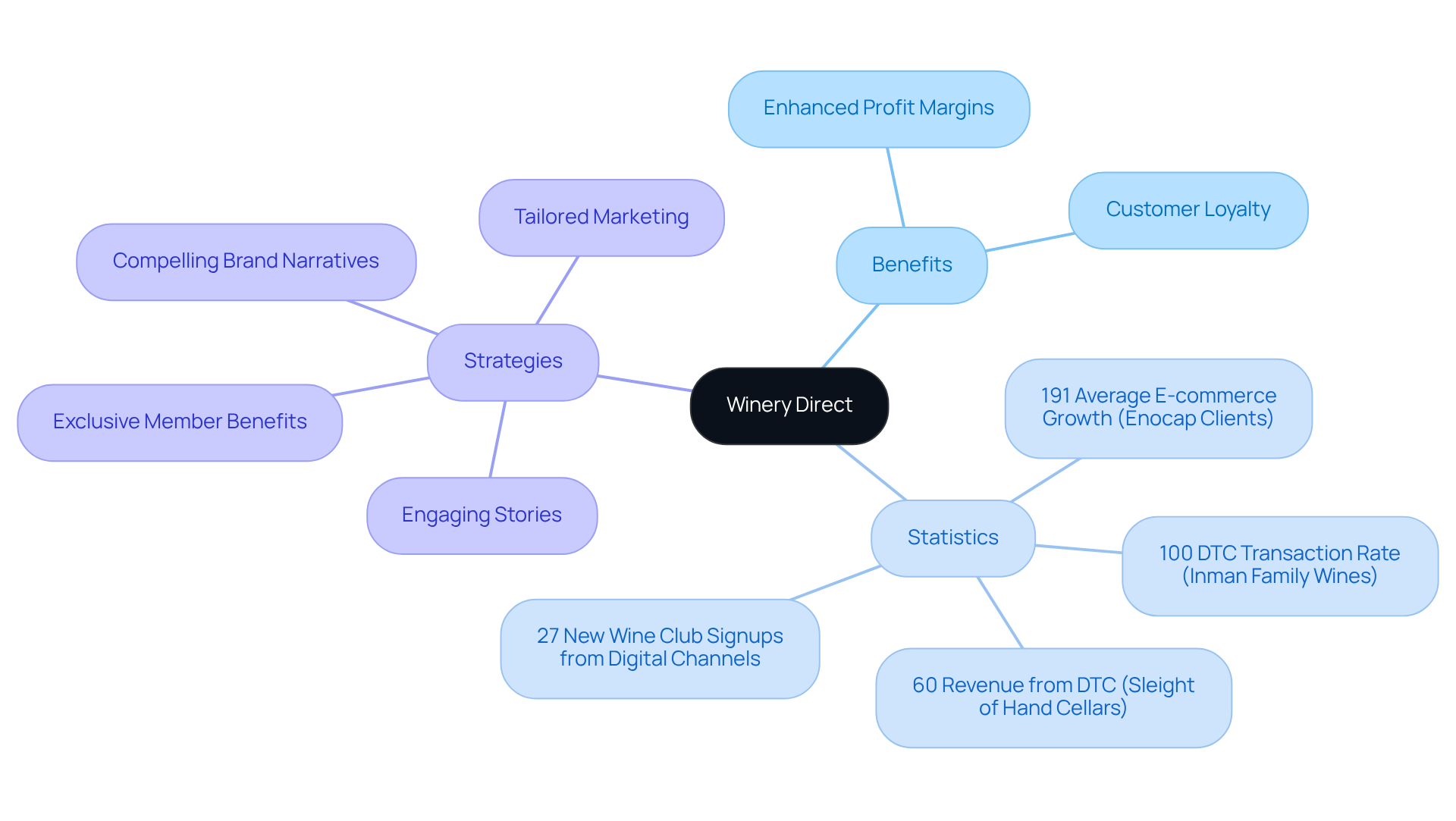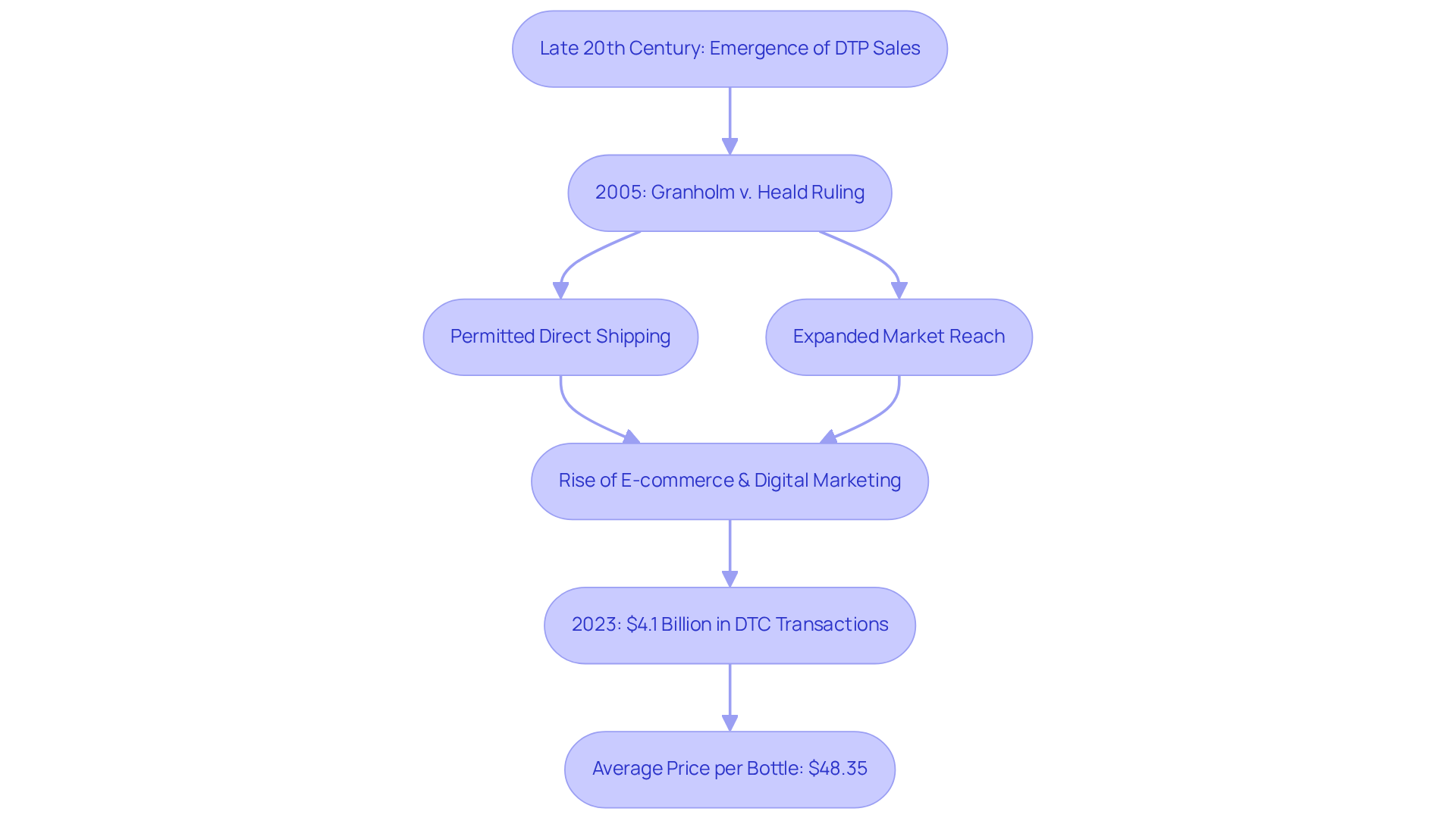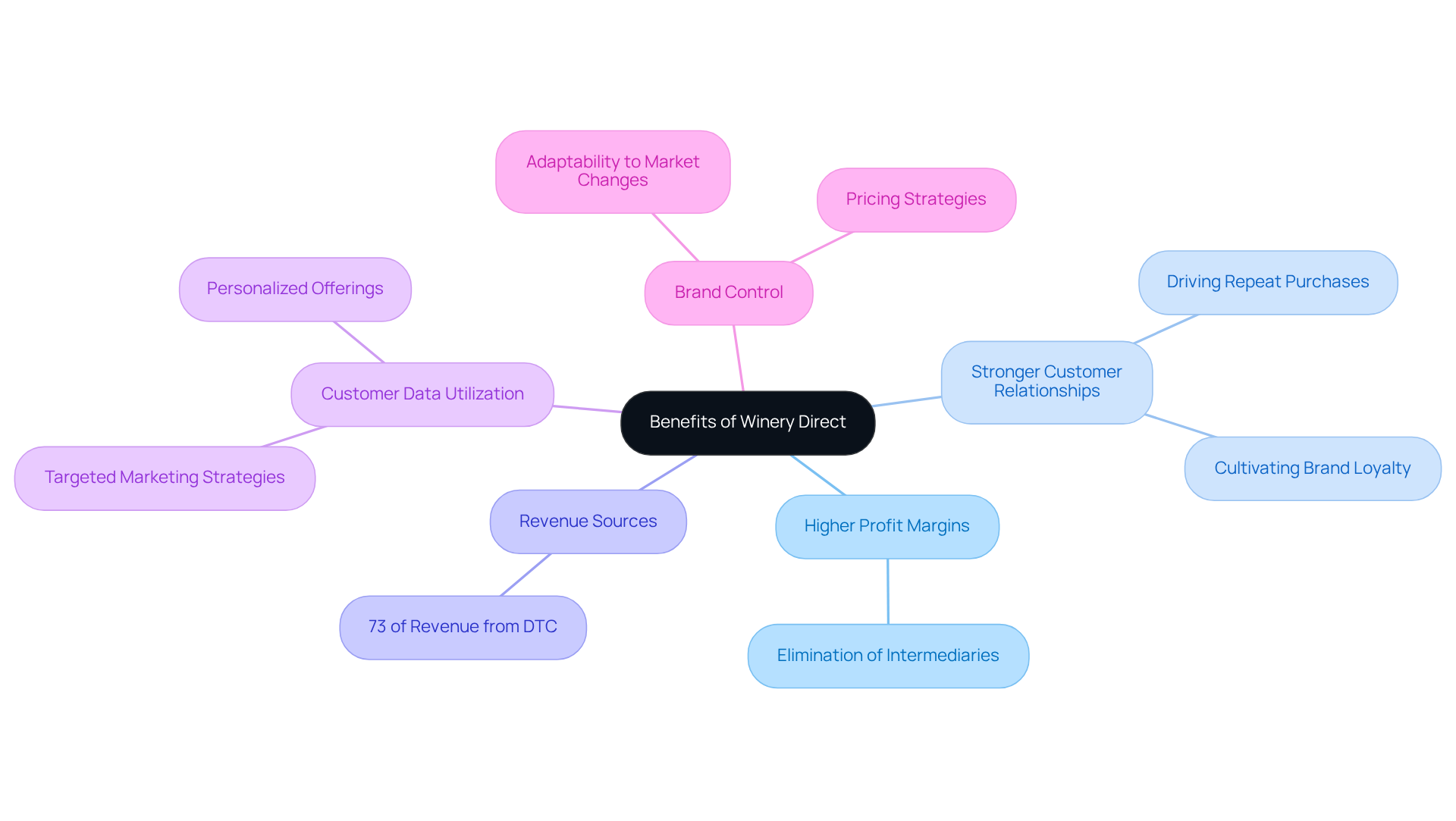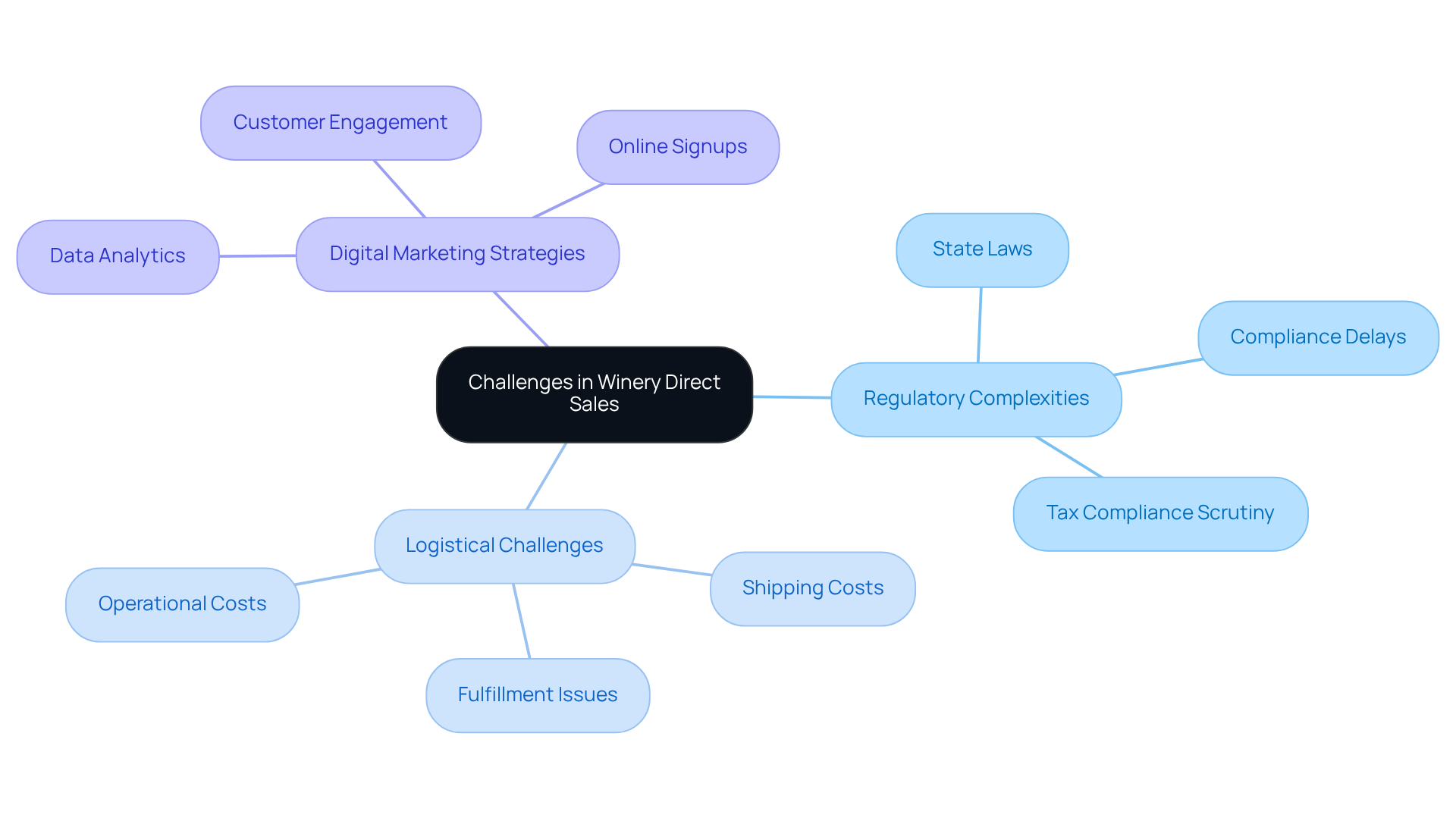Overview
Winery Direct represents a pivotal shift in the wine industry towards a direct-to-consumer (DTC) sales model. This approach empowers vineyards to sell their products directly to consumers, significantly enhancing both profitability and customer loyalty. Notably, this model has gained substantial traction, primarily due to its ability to eliminate intermediaries.
Recent statistics reveal that a considerable portion of vineyard revenue now derives from DTC sales, underscoring the necessity for wineries to adapt to evolving consumer preferences and strategically leverage e-commerce for success.
As the landscape of the wine market continues to evolve, embracing the DTC model is not just beneficial; it is essential for sustained growth and competitiveness.
Introduction
The wine industry is experiencing a profound transformation as vineyards increasingly embrace direct-to-consumer (DTC) sales, fundamentally redefining traditional distribution methods. This strategic approach not only fortifies the connection between producers and consumers but also significantly enhances profitability by eliminating intermediaries. Yet, as wineries adopt this innovative model, they confront a complex landscape of regulations and logistical challenges that could impede their success.
How can vineyards adeptly navigate these obstacles while maximizing the advantages of winery direct sales?
Define Winery Direct: Understanding Direct-to-Consumer Wine Sales
What is winery direct? It represents a transformative approach in the wine industry, where vineyards sell their products directly to consumers, effectively bypassing traditional distribution channels such as wholesalers and retailers. This model fosters a direct connection between producers and customers, significantly enhancing brand loyalty and maximizing profit margins. By eliminating intermediaries, producers can offer competitive pricing while retaining a greater share of revenue. This strategy has gained momentum as vineyards adapt to shifting consumer preferences and market dynamics.
The benefits of direct-to-consumer transactions are substantial. Wineries adopting this model frequently experience enhanced profit margins, as they capture the full retail price without the need to share it with distributors. Notably, producers like Inman Family Wines have achieved a remarkable 100% direct-to-consumer transaction rate over the past four years, highlighting the potential for ongoing revenue growth. Additionally, 60% of revenue at Sleight of Hand Cellars now comes from DTC sales, with ambitions to raise this figure to 90%, reflecting a strong commitment to this sales strategy.
Furthermore, the influence of direct-to-consumer sales on vineyard profit margins is significant. With for clients of advisory firms like Enocap soaring by 191% in 2020, it is clear that DTC channels can greatly enhance financial performance. This growth is further underscored by the fact that 27% of new wine club signups originate from digital channels, emphasizing the critical role of online engagement in today’s market.
To optimize DTC revenue and foster customer loyalty, family-owned wineries can adopt transformative strategies, including compelling brand narratives and strategic capital planning. Specific tactics for converting casual purchasers into dedicated club members encompass tailored marketing, exclusive member benefits, and engaging stories that resonate with customers. For instance, Clif Family Winery's innovative subscription model, 'The Wine Drop,' has recorded an impressive 244% increase in sign-ups compared to traditional wine clubs, appealing particularly to younger demographics. This shift towards adaptable and enticing products is crucial as vineyards respond to generational changes in wine consumption, with older individuals drinking less and younger consumers seeking more accessible options.
In conclusion, understanding what is winery direct not only facilitates a closer connection between producers and their customers but also positions them to excel in a competitive landscape by maximizing profitability and nurturing brand loyalty through strategic DTC initiatives.

Contextualize Winery Direct: The Evolution of DTC Sales in the Wine Industry
The emergence of direct-to-purchaser (DTP) sales within the wine sector began in the late 20th century, leading to an exploration of what is winery direct, as producers recognized the potential of selling directly to consumers. A pivotal moment occurred in 2005 with the Supreme Court's Granholm v. Heald ruling, which permitted vineyards to ship directly to consumers across state lines, thereby significantly broadening their market reach. This ruling not only facilitated interstate commerce but also helped to explain what is winery direct, empowering wineries to forge a more personal connection with their customers.
In the years following this landmark decision, the advent of e-commerce and digital marketing has further accelerated the growth of DTC transactions. Wineries have increasingly leveraged online platforms to engage with buyers, leading to a notable shift in purchasing behavior. As of 2023, understanding what is winery direct, DTC transactions accounted for approximately $4.1 billion, representing about 5% of total U.S. wine revenue. This growth underscores a preference for personalized experiences and direct engagement with brands.
Data indicates that DTC transactions have become a vital income source for vineyards, with online commerce expansion averaging 191% for clients of consulting firms like Enocap in 2020. Additionally, the average price per bottle of DTC wine shipped rose to $48.35 in 2023, reflecting a trend toward higher-value purchases. The ability to engage directly with customers has enabled vineyards to cultivate loyalty and enhance their narratives, illustrating what is winery direct as a fundamental component of their business strategies.
As the wine sector continues to evolve, the importance of DTC transactions is underscored by the ongoing challenges and opportunities presented by market dynamics. Wineries that adapt to these changes and are better positioned to excel in an increasingly competitive landscape.

Explore Key Characteristics: Benefits of Winery Direct for Wineries
The extensive and undeniable benefits of vineyards can be understood by exploring what is winery direct. Primarily, it facilitates significantly greater profit margins, as producers retain a larger share of revenue by eliminating intermediaries. Direct-to-consumer (DTC) transactions foster the development of stronger customer relationships, which are vital for cultivating brand loyalty and driving repeat purchases. Notably, data indicates that 73% of typical vineyard revenue now stems from direct-to-consumer channels, underscoring the importance of this model in today’s market.
Additionally, vineyards can capitalize on direct interactions to gather valuable customer data, which enables more targeted marketing strategies and personalized offerings. Successful wine clubs illustrate this approach by crafting exclusive experiences for members, thereby enhancing and retention. In fact, 27% of new wine club signups originate from digital channels, highlighting the effectiveness of an online presence in attracting loyal customers.
Furthermore, DTC transactions grant producers enhanced control over their brand narrative and pricing strategies, allowing them to swiftly adapt to market fluctuations. This flexibility is crucial in an industry where consumer preferences are rapidly evolving. By embracing DTC commerce and securing the necessary funding through strategic planning with Enocap, vineyards not only bolster their profit margins but also cultivate a dedicated customer base that understands what is winery direct, which is essential for their long-term success.

Address Challenges: Navigating the Complexities of Winery Direct Sales
The Direct model, which raises the question of what is winery direct, offers significant benefits, yet it also presents several challenges that wine producers must navigate with expertise.
- Regulatory complexities, particularly the diverse state laws governing direct shipping, can complicate the sales process considerably.
- Compliance with these varying regulations often leads to delays and increased operational costs.
- Moreover, logistical challenges related to shipping and fulfillment become more pronounced as vineyards scale their operations.
- High shipping expenses, a major obstacle for consumers, necessitate that vineyards enhance their logistics to pursue more economical solutions.
- Statistics indicate that rising shipping costs are a key factor contributing to the decline in DTC wine transactions, underscoring the urgency for producers to address these challenges.
To effectively reach and , wine producers must understand what is winery direct and invest in robust marketing and technology solutions.
- With 27% of new wine club signups originating through digital channels, leveraging data analytics and innovative digital marketing strategies is crucial for boosting DTC sales efforts.
- Enocap offers extensive advisory services, including demand generation strategies and customer retention programs, that assist family-owned vineyards in overcoming these challenges by fostering DTC growth, enhancing brand narratives, and securing strategic capital.
By confronting these challenges and adapting to consumer engagement trends, vineyards can establish a sustainable business model that thrives in a competitive environment.
Ready to transform your winery's growth? Schedule a complimentary 30-minute growth audit to uncover opportunities tailored to your winery's unique situation.

Conclusion
Understanding winery direct sales is crucial for grasping the evolving landscape of the wine industry. This model not only enables vineyards to connect directly with consumers but also enhances profitability by eliminating intermediaries. By embracing direct-to-consumer (DTC) strategies, wineries can foster deeper relationships with their customers, ultimately leading to increased brand loyalty and a more sustainable business model.
The significance of profit margins achieved through DTC sales cannot be overstated. Engaging narratives and tailored marketing approaches are essential, yet the challenges posed by regulatory complexities and shipping logistics must also be acknowledged. Noteworthy statistics highlight the substantial growth in e-commerce for wineries and the increasing percentage of revenue derived from DTC channels, underscoring the necessity for producers to adapt to shifting consumer preferences and market dynamics.
As the wine industry continues to embrace the winery direct model, it is essential for vineyards to leverage technology and innovative marketing strategies to overcome challenges. By doing so, they can not only enhance their profitability but also create memorable experiences for their customers. The future of the wine industry lies in the direct connections that wineries forge with consumers, making it imperative for producers to prioritize DTC sales as a cornerstone of their growth strategies.
Frequently Asked Questions
What does "winery direct" mean?
Winery direct refers to a sales model in the wine industry where vineyards sell their products directly to consumers, bypassing traditional distribution channels like wholesalers and retailers. This approach enhances brand loyalty and maximizes profit margins for producers.
What are the benefits of direct-to-consumer wine sales?
The benefits include enhanced profit margins for wineries, as they capture the full retail price without sharing it with distributors. This model also fosters a direct connection with customers, leading to increased brand loyalty and revenue growth.
How have wineries like Inman Family Wines and Sleight of Hand Cellars performed with direct-to-consumer sales?
Inman Family Wines has achieved a 100% direct-to-consumer transaction rate over the past four years, while Sleight of Hand Cellars generates 60% of its revenue from DTC sales, with plans to increase this figure to 90%.
What impact does direct-to-consumer sales have on vineyard profit margins?
Direct-to-consumer sales significantly enhance profit margins, with average e-commerce growth for clients of advisory firms like Enocap rising by 191% in 2020. This indicates that DTC channels can greatly improve financial performance for vineyards.
What role does digital engagement play in direct-to-consumer sales?
Digital engagement is critical, as 27% of new wine club signups come from digital channels. This highlights the importance of online strategies in attracting customers and driving sales.
What strategies can family-owned wineries use to optimize direct-to-consumer revenue?
Wineries can adopt strategies like creating compelling brand narratives, strategic capital planning, tailored marketing, offering exclusive member benefits, and sharing engaging stories to convert casual purchasers into dedicated club members.
How has Clif Family Winery innovated its approach to direct-to-consumer sales?
Clif Family Winery introduced an innovative subscription model called 'The Wine Drop,' which has seen a 244% increase in sign-ups compared to traditional wine clubs, particularly appealing to younger demographics.
How are consumer preferences changing in the wine market?
There is a shift towards younger consumers seeking more accessible wine options, while older individuals are drinking less. Wineries are adapting their products and marketing strategies to cater to these generational changes in wine consumption.




